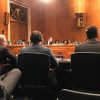The U.S. Department of Education must redouble its efforts to ensure that states comply with the Every Student Succeeds Act (ESSA), said David Steiner, executive director of the Johns Hopkins Institute for Education Policy, in testimony before the U.S. Senate Health, Education, Labor, and Pensions Committee.
“ESSA’s promise of flexibility does not provide states with a license to fail historically underserved students,” he said in his opening remarks. “While some state plans include very promising, highly innovative policy, it is difficult to assert that all aspects of approved state plans have fully met ESSA’s requirements and the spirit of the law.”
A bipartisan coalition passed ESSA in 2015. Its promise, Steiner explained, had been to liberate states to craft education policy sensitive to their different contexts and missions. But the educational performance of students in all 50 states remains deeply uneven. He cited an analysis by the National Center for Education Statistics that found the lowest-performing states providing a mathematics education equivalent to those in Ukraine, Kazakhstan and Armenia. In recognition of this reality, Congress included “guardrails” in ESSA to ensure that states, districts and schools were held accountable for the performance of all students.
“ESSA does give states much freedom, but not the freedom to fail millions of underserved students,” said Steiner. “There are critical federal guidelines that must not be ignored. By fail I mean drastically reducing students’ life prospects by providing an education we know to be inadequate.”
For instance, Steiner noted that the statute requires states to identify schools for “targeted” support if one or more subgroups of students consistently underperform. A subgroup refers to certain racial and ethnic minorities, students with special needs, English Language Learners and economically disadvantaged students.
States must also use academic and nonacademic data from their accountability systems to identify schools in need of “comprehensive” support, which must include the lowest-performing 5 percent of all schools in the state and high schools with graduation rates of lower than 67 percent.
“ESSA requires states to support low-performing schools with evidence-based practices; indeed evidence-based is referenced almost 60 times in ESSA,” said Steiner. He noted, however, that Education Secretary Betsy DeVos has removed references to evidence-based interventions from the ESSA state template.
ESSA also requires state plans to describe how the state will ensure that historically underserved students are not taught disproportionately by ineffective or inexperienced teachers. “All of us know that this is a critical issue,” said Steiner. “Yet this is one area where far too many states are offering small, piecemeal policies and remedies, at best.”
In addition, ESSA requires states to use one, regular high-school diploma to calculate graduation rates. States, however, often hold different groups of students to vastly different graduation requirements, while awarding all of them the same graduation diploma.
“I encourage continued oversight on the part of the Department of Education on these issues,” he said. “Last year in my own city of Baltimore, over one-third of last year’s high-school graduates received their diploma having failed the standard state requirements.”
The students were given an alternative route—a project that almost none of them failed. “Maryland is sadly not alone in offering these diverse pathways with different academic rigor. This is why ESSA matters, and this is why attention to legislative detail matters.”
Steiner was joined at the witness table by the state commissioners of education from Louisiana, Tennessee and New Mexico. He praised them at the hearing for their comprehensive and forward-looking ESSA plans. Washington State Senator Patty Murray asked Steiner what concerned him the most about other states’ plans.
“Some plans that have been approved do not indicate how subgroup performances will even factor into school ratings or the criteria by which low-performing schools will be exited from their improvement status,” he said. “Some plans are deeply vague about consistently underperforming subgroups. There has to be a clear definition of ‘consistently underperforming,’ otherwise we won’t reach those students.”
Asked by Colorado Senator Michael Bennet to identify the factors that challenge the performance of American students, Steiner maintained that in the end two issues stand out: “What we teach and how effectively we teach it. In short, curriculum and teacher quality are job number one.”

